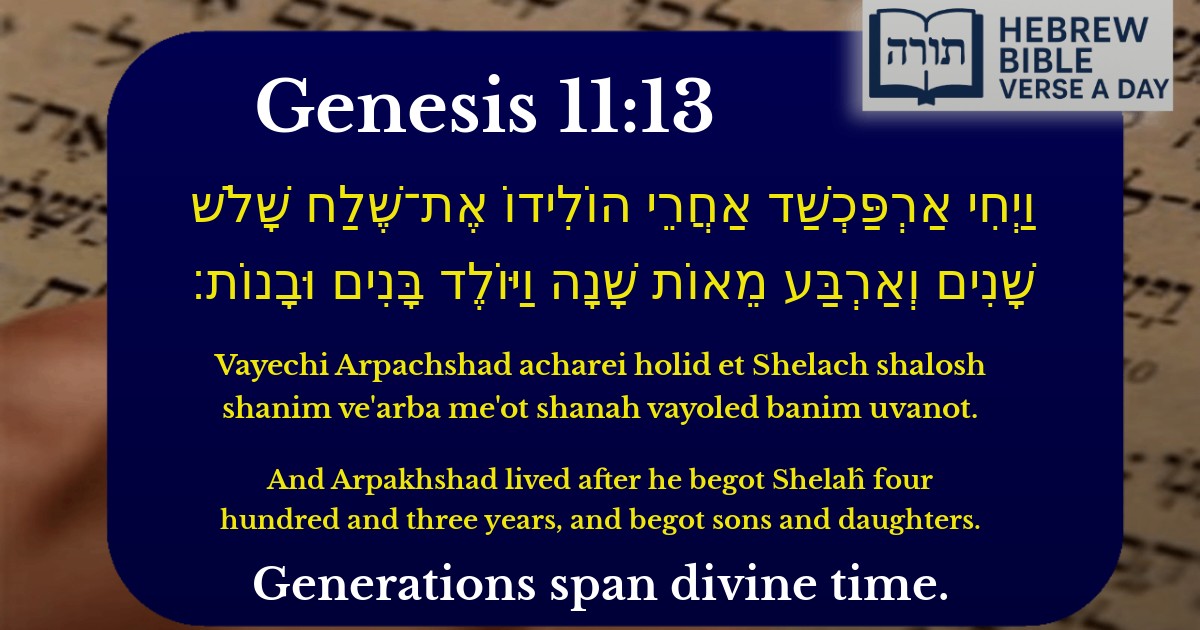Frequently Asked Questions
Q: What does Genesis 11:13 mean when it says Arpakhshad lived after fathering Shelah?
A: The verse tells us that Arpakhshad lived 403 years after the birth of his son Shelah, during which time he had more children. This follows the Torah's pattern of listing generations from Adam to Avraham, showing the continuity of humanity. Rashi explains that these long lifespans allowed for the transmission of tradition from one generation to the next.
Q: Why does the Torah list how long people lived after having children?
A: The Torah records these details to show the unbroken chain of tradition from Adam through the generations. Rambam teaches that these genealogies demonstrate how divine knowledge was passed down through righteous individuals. The long lifespans allowed fathers to teach their children and grandchildren directly.
Q: How old was Arpakhshad when he died according to the Torah?
A: While this verse doesn't state his total age, by comparing with Genesis 11:12 which says he was 35 when Shelah was born, plus the 403 years mentioned here, we learn Arpakhshad lived to be 438 years old. The Talmud (Sanhedrin 69b) discusses these calculations in detail.
Q: Why are the lifespans in Genesis so much longer than today?
A: Our sages give several explanations. The Midrash (Bereishit Rabbah) says early generations were closer to creation and thus had more vitality. Others suggest these long lives were necessary to establish civilization. Rambam notes that as humanity multiplied, lifespans gradually decreased to what we know today.
Q: What lesson can we learn from Arpakhshad's life in Genesis 11:13?
A: The verse teaches the importance of building family and continuing the chain of tradition. Though only Shelah is named, the mention of 'sons and daughters' shows that each person contributes to future generations. The Sforno explains this highlights our responsibility to raise children who will carry on Jewish values.


Understanding the Verse
The verse states: "And Arpakhshad lived after he begot Shelaĥ four hundred and three years, and begot sons and daughters" (Genesis 11:13). This follows the pattern of the genealogical records in Parashat Noach, detailing the lifespan and descendants of the generations from Noach to Avraham.
Rashi's Commentary
Rashi (Rabbi Shlomo Yitzchaki) notes that the Torah emphasizes how long Arpakhshad lived after the birth of Shelaĥ to teach that these years were meaningful and productive. Unlike earlier generations, where long lifespans were common, the Torah highlights that Arpakhshad continued to fulfill his purpose by fathering more children and contributing to the world.
Chronological Significance
According to Seder Olam Rabbah, the detailed chronology of these generations is essential for calculating the timeline from Creation to the Exodus. Arpakhshad was born two years after the Flood (Seder Olam 1), and his lifespan connects the post-Flood era to the era of Avraham Avinu.
Spiritual Interpretation (Midrash)
The Midrash (Bereishit Rabbah 37:7) suggests that the names of these generations carry deeper meanings. Arpakhshad (אַרְפַּכְשַׁד) may be interpreted as "a language (or border) of fire", alluding to the dispersion at the Tower of Bavel, which occurred during his lifetime. His son Shelaĥ (שֶׁלַח) means "sent," possibly hinting at the spreading of humanity across the earth.
Rambam's Perspective
Rambam (Maimonides) in Moreh Nevuchim (Guide for the Perplexed 2:47) discusses the extended lifespans of early generations as a reflection of a purer physical and spiritual state before the gradual decline in human vitality over time.
Key Lessons